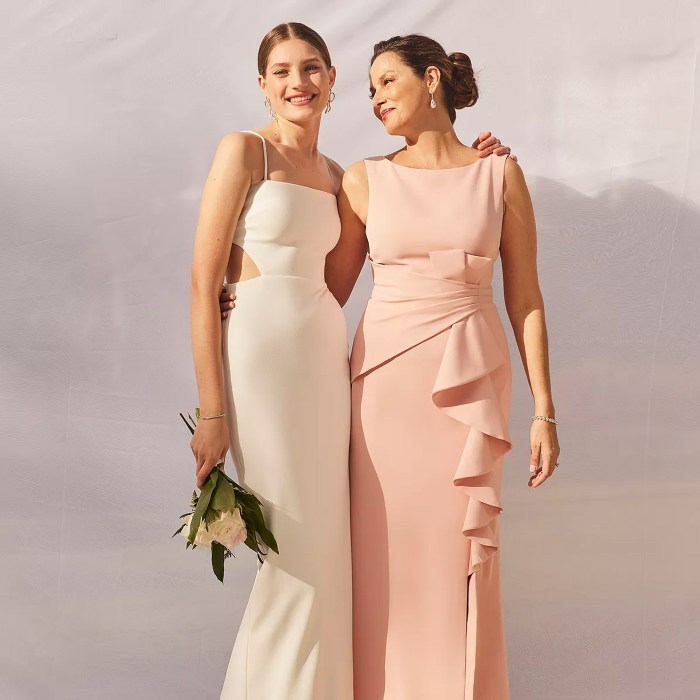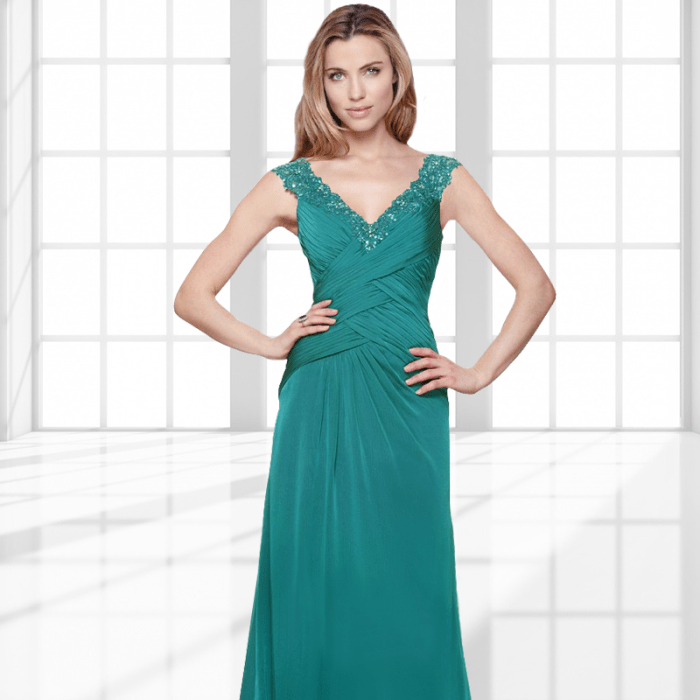Styles and Trends in Mother of the Bride Dresses
Mother of bride wedding dress – Choosing a mother-of-the-bride dress involves navigating a landscape of styles, trends, and considerations to ensure a flattering and appropriate look for the special occasion. This section explores current trends, dress styles, and how to flatter different body types.
Popular Mother-of-the-Bride Dress Styles
Several dress styles consistently flatter various body types. The choice often depends on personal preference, the wedding’s formality, and the venue.
| Style | Neckline | Sleeve Length | Silhouette |
|---|---|---|---|
| A-line | V-neck, sweetheart, round | Sleeveless, short, three-quarter, long | Fitted at the waist, gradually flaring out to the hem, creating an “A” shape. This style is universally flattering. |
| Sheath | Boat neck, scoop neck, halter | Sleeveless, cap sleeves, elbow-length | Fitted from shoulder to hem, emphasizing the body’s shape. Suitable for slimmer figures. |
| Ballgown | Sweetheart, off-the-shoulder, bateau | Sleeveless, short, long | Fitted bodice and a full, flowing skirt. Adds volume and is ideal for creating a dramatic look. |
| Tea-length | Round neck, V-neck, jewel neck | Sleeveless, short, three-quarter | Fitted or semi-fitted bodice with a skirt that falls to the mid-calf. Elegant and versatile. |
Current Fashion Trends in Mother-of-the-Bride Dresses
Current trends in mother-of-the-bride dresses reflect a blend of classic elegance and modern flair. Color palettes, fabrics, and embellishments play a significant role in shaping the overall aesthetic.
Color Palettes: Rich jewel tones like emerald green, sapphire blue, and ruby red remain popular, alongside softer shades of blush pink, lavender, and champagne. Muted tones and earthy neutrals are also gaining traction, offering a sophisticated and timeless look.
Fabrics: Luxurious fabrics such as silk, crepe, and lace continue to be favored for their drape and elegance. Modern interpretations incorporate textured fabrics like brocade and velvet for added visual interest.
Embellishments: Subtle embellishments such as delicate beading, embroidery, or lace appliqués add a touch of glamour without overpowering the overall design. Clean lines and minimalist designs are also trending, emphasizing the quality of the fabric and the dress’s cut.
Flattering Dresses for Different Body Types: A-line dresses are generally flattering on most body types. Sheath dresses suit those with slimmer figures, while empire waist dresses can camouflage a larger midsection. Pear shapes might prefer A-line or fit-and-flare dresses, while those with a larger bust might opt for a V-neck or bateau neckline to balance proportions.
Fabric and Material Choices
The fabric selection significantly impacts the dress’s drape, comfort, cost, and overall appearance. Understanding the properties of various fabrics is crucial for making an informed decision.
Comparison of Common Fabrics
- Silk: Luxurious, drapes beautifully, delicate, requires professional cleaning, expensive.
- Chiffon: Lightweight, sheer, flows gracefully, can be easily wrinkled, less structured.
- Lace: Elegant, intricate detailing, can be delicate, requires careful handling, can be itchy.
- Crepe: Drapes well, wrinkle-resistant, matte finish, durable, versatile.
- Velvet: Luxurious, rich texture, can be heavy, may be warm, requires careful cleaning.
Advantages and Disadvantages of Fabrics
The choice of fabric depends on the desired aesthetic and the season. Silk and chiffon offer luxurious drape but require more care, while crepe and other wrinkle-resistant fabrics provide ease of maintenance. Heavier fabrics like velvet are ideal for cooler months, while lighter fabrics are suitable for warmer climates.
Fabric Choice and Cost/Maintenance
Luxurious fabrics like silk and lace generally command a higher price tag due to their quality and production methods. These fabrics often require professional dry cleaning, adding to the overall cost of ownership. More durable and easy-care fabrics like crepe offer a more budget-friendly and practical option.
Color Selection and Coordination
Color selection is crucial for creating a cohesive and aesthetically pleasing look. This section explores color palettes, coordination with other elements, and flattering colors for various skin tones.
Color Palettes for Different Wedding Themes

Source: greenweddingshoes.com
Finding the perfect mother of the bride wedding dress can be challenging, but don’t limit yourself to tradition! Explore options beyond the expected, perhaps drawing inspiration from the breathtaking designs showcased in our gallery of most unusual wedding dresses. You’ll find unique silhouettes and embellishments that can inform your own stylish and memorable choice for the big day.
Let your personality shine through with a mother-of-the-bride dress that’s as individual as you are.
| Wedding Theme | Complementary Color Palette |
|---|---|
| Rustic | Earthy tones: blush pink, sage green, ivory |
| Beach | Pastel shades: light blue, coral, mint green |
| Formal | Rich jewel tones: emerald green, sapphire blue, ruby red |
| Modern | Neutral tones with pops of color: navy, blush pink, silver |
Coordinating with Bridesmaids and Wedding Aesthetic, Mother of bride wedding dress
The mother-of-the-bride dress should complement, not compete with, the bridesmaids’ dresses and the overall wedding aesthetic. It’s essential to avoid clashing colors or styles. Communication with the bride is key to ensure a harmonious look.
Flattering Colors for Different Skin Tones
Warm skin tones often look best in warm colors like gold, peach, and coral. Cool skin tones generally suit cooler colors like blue, purple, and silver. Neutral skin tones can wear a wider range of colors.
Finding the Perfect Dress: Shopping and Considerations
Navigating the mother-of-the-bride dress shopping process requires careful planning and consideration of various factors. This section provides a step-by-step guide and essential advice.
Step-by-Step Guide to Dress Shopping
- Set a budget and stick to it.
- Determine the wedding’s style, theme, and color palette.
- Consider the venue and season.
- Browse online and in stores for inspiration.
- Schedule appointments at bridal shops or boutiques.
- Try on different styles and fabrics.
- Seek feedback from trusted friends and family.
- Purchase the dress and schedule alterations if needed.
Setting a Budget and Sticking to It
Establishing a realistic budget before shopping prevents overspending. Consider the cost of the dress, alterations, accessories, and any other related expenses.
Key Factors to Consider When Choosing a Dress
Factors such as the wedding venue (formal or casual), the season (summer or winter), and the mother’s personal style should all influence the dress selection. The formality of the wedding will dictate the level of formality required for the dress.
Accessories and Styling: Mother Of Bride Wedding Dress
Accessories play a crucial role in completing the mother-of-the-bride look. This section describes a sample outfit and how accessories can transform the overall style.
Visual Description of a Mother-of-the-Bride Outfit
Imagine a sophisticated ensemble: a navy blue crepe A-line dress with a subtle V-neckline and three-quarter sleeves. The dress features delicate beading along the neckline. Paired with elegant nude heels, a matching clutch with subtle silver detailing, and understated pearl earrings and necklace. The textures are smooth and refined, the colors are classic and timeless, and the shapes are streamlined and flattering.
Impact of Accessories on the Overall Look

Source: inweddingdress.com
Switching to a bold statement necklace could transform the look from understated elegance to glamorous sophistication. A brighter colored clutch or shoes could add a pop of color, while a different hairstyle or hat could further alter the aesthetic.
Choosing Accessories to Complement the Dress and Wedding Style
Accessories should complement the dress and the overall wedding style. If the wedding is rustic, natural elements like wooden beads or flowers might be appropriate. For a modern wedding, sleek metallic accessories might be a better choice.
Etiquette and Considerations
Certain unspoken rules and etiquette guide the mother-of-the-bride’s dress selection. This section Artikels these considerations and offers advice for handling potential conflicts.
Unspoken Rules and Etiquette
- Avoid upstaging the bride.
- Choose a dress that is appropriate for the venue and time of day.
- Consider the wedding’s color palette and theme.
- Ensure the dress is comfortable and flattering.
- Communicate with the bride about dress selection.
Importance of Communication and Collaboration
Open communication between the mother-of-the-bride and the bride is essential to ensure everyone is happy with the dress choice. The bride’s preferences and vision for the wedding should be considered.
Handling Potential Conflicts or Disagreements
Disagreements can be resolved through open and respectful communication. Compromise and mutual understanding are key to ensuring a positive relationship between the mother and the bride.
FAQ Resource
What’s the average price range for a mother-of-the-bride dress?
Prices vary widely depending on designer, fabric, and embellishments, ranging from a few hundred to several thousand dollars.
When should I start shopping for my mother-of-the-bride dress?
Ideally, begin shopping 6-9 months before the wedding to allow ample time for alterations and potential shipping delays.
How do I handle disagreements with the bride about my dress choice?
Open communication is key. Discuss your preferences early, showing the bride pictures and respecting her vision while expressing your comfort level.
Can I wear a pantsuit instead of a dress?
Absolutely! A stylish pantsuit can be a chic and comfortable alternative, especially for more modern or informal weddings.
Should I bring someone with me when dress shopping?
Yes! Bring a trusted friend or family member whose opinion you value to help you narrow down your options and offer unbiased feedback.
